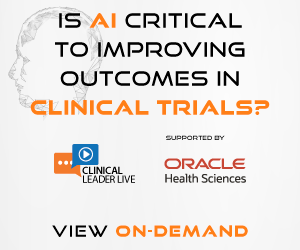Bayer Overhauls Its Clinical Trial Planning Process

By Ed Miseta, Chief Editor, Clinical Leader

In clinical development, patient enrollment is one of the key challenges sponsor companies face. Research from the Tufts Center and other sources has shown that 80 percent of sites will fail to meet enrollment timelines and another 10 percent will never enroll a single patient. To make matters worse, up to 20 percent of Phase 3 trials are terminated due to issues surrounding patient enrollment. So, while trials today are gathering more data than ever before and benefit from access to constantly improving technologies and analytics, many are still plagued by the patient and site recruitment challenge.
Bayer is one company that decided that in order to get much needed medicines to patients faster and more efficiently, this had to change. In 2015 the company decided to take a hard look at how it selected patients and sites, and how it prepared protocols and conducted planning for trials. A transformation program was put in place by senior management to oversee those changes and bring insights to the internal development teams.
“We completely changed our approach,” says Subrata Bose, global head of Clinical Trials Analytics & Insights for Bayer AG. “One of the biggest changes was in feasibility. In the past we waited until we had developed our final protocol before performing feasibility planning. We now start that planning very early, so we can look at feasibility as we are developing the protocol.”
The feasibility process at Bayer now begins with a review of an early draft of the protocol. That draft will note primary and secondary end points as well as inclusion and exclusion criteria. The clinical team will first look at the indication to determine what experience the company has in that area. The team will then determine what countries need to be involved in the study and what hospitals and sites should be considered. They will look at Bayer’s own historical data and gather data from outside sources as well. The goal is to create a focused and targeted list of potential clinical sites.
Rethink Site Surveys

Today the surveys are very different. They still attempt to garner some of the same information about the trial, but the questions are specific. According to Bose, the key to gaining good insights is to ask pointed questions, as vague questions can lead to vague responses. Pointed questions lead to actionable insights. For example, instead of asking what should be changed about the protocol, a question might be whether four blood draws over a 14-day period would be difficult for patients to endure.
The insights gleaned from the surveys are already helping increase efficiency. The pointed questions have led to an improved response rate. Bose says the industry response rate for site surveys is approximately 61 percent. For Bayer that number has swelled to 90 percent.
A Better Trial Experience
The biggest benefit of the surveys is understanding what sites like and dislike about a protocol, and what areas need to be changed. Bose believes the effort will not only help with site and patient recruitment but will make trials more patient centric. Expensive and time-consuming protocol changes once the study is up and running are avoided.
“We care about their thoughts on the operational and medicinal aspects of the protocol,” says Bose. “We value their insights on the inclusion and exclusion criteria and whether they think the trial is easily executable. Since every country has a different standard of care, we are creating survey variations. We strive to gain patient insights from the study investigators. If we had a certain number of tests or site visits required from a patient, the site can tell us if that is reasonable or if it needs to be reduced.”
The information gathered from sites is combined with knowledge that exists within Bayer. Bose states the combination of the two sources of data helps Bayer determine which countries and sites are best suited for certain trials. The end result is trials that are better designed and planned. Bayer is now completing more trials on time and insights are carried over into future trials as well.
According to Bose, Bayer has reduced its study startup time for both Phase 2 and Phase 3 studies and is now conducting them almost a month faster than the industry average. By reaching out to the right sites, Bayer has also been successful at minimizing the number of sites that never recruit a single patient.
A New Analytics platform
Despite the success, Bayer quickly realized that a platform was needed to store the data and automate workflows. The system would have to allow for better collaboration and data visualization, and all stakeholders in the clinical trial process, both internal and external, would need access to the data.
“If you want to perform a large trial in a certain country, a site management organization in that country will not necessarily have the information needed to recruit the sites and patients you need,” says Bose. “In those situations, we provide them with the insights we have gathered. We consolidate that information so site management and other organizations can access the intelligence.”
Bose is referring to site analytics. When the company recognized that the wealth of information that it had gathered for years could be valuable, a platform to store, retrieve, and share the insights was needed. Moving forward, someone designing a study in a certain indication will be able to see how sites performed in the past and what the standard of care and regulatory requirements are in different countries – without having to repeat the same work done on earlier studies. As information is used and shared, it is also updated.
“If you want to know how many patients Site XYZ might recruit for a cardiovascular study, you can now look at data that shows you their past performance,” says Bose. “And site management organizations and other strategic partners you work with will have access to the same information. Every country has its own clinical challenges, so we are also trying to understand and document those as well.”
Select the Right Technology Partner
The system Bayer opted to put in place is the Data Driven Feasibility solution of ADD Analytics and Insights and eSurvey tool of ADD Patient and Site Engagement from Tata Consultancy Services (TCS). Bose notes the insights generated by the platform incorporate real world data, which is more valuable than simply relying on historical data.
Bayer has a goal of being a partner of choice for sites and welcomes the efficiencies the platform will bring to investigators. One goal was to eliminate the administrative burden on site personnel, and the survey tool will assist with that. To complete a survey, investigators do not have to type anything. They can engage in conversation with a Bayer representative and have their responses recorded.
A More Collaborative Process
The platform will also make it easier for investigators to provide feedback and recommendations on the protocol and inclusion/exclusion criteria. Bose believes this helps investigators feel they are part of a scientific journey and not just executing a pharma company’s protocol. Sites no longer must be queried on the number of staff members in the clinic or the type of equipment they possess, so the questions can focus on input regarding the study.
“That feedback is critical,” says Bose. “We use that site feedback to conduct protocol feasibility. We get feedback from hospitals and clinics because we know we cannot develop protocols in an isolated manner. That process must be collaborative. Sites understand their patients and can ensure our protocols are patient centric. They know what tests and procedures will be acceptable to patients and which ones won’t be.”
To build this infrastructure, Bose opted for an agile approach, starting out with a prototype. Once actionable insights started to roll in, he was able to use that data to demonstrate the value of the platform.
“By starting out with a prototype that was built as a result of design thinking methodology, we were able to get our employees to be part of the journey,” he says. “They could see how this platform would improve our trials. We had some issues and a few bugs, but we were able to resolve them easily. With any infrastructure investment, I believe it is important to start slowly with a prototype and then show the benefits to build your business case.”
Patient enrollment and retention are vital to a trial’s success. Bose concludes: “Introducing analytics into the development of study protocols has allowed us data-driven decision-making. We already see improvements in study conduct, which will help us to get new medicines to patients faster.”

